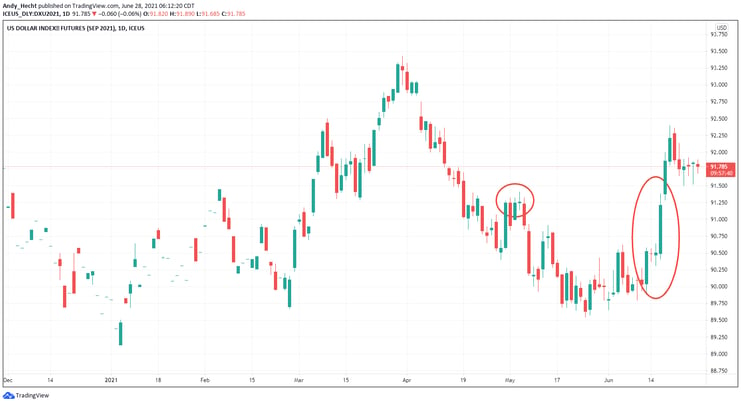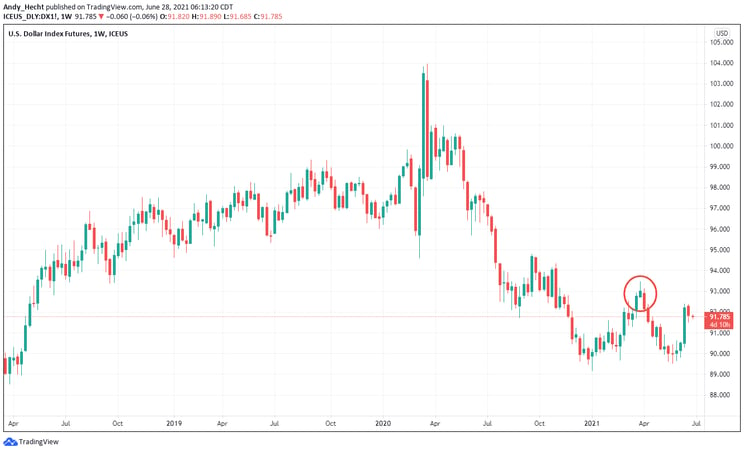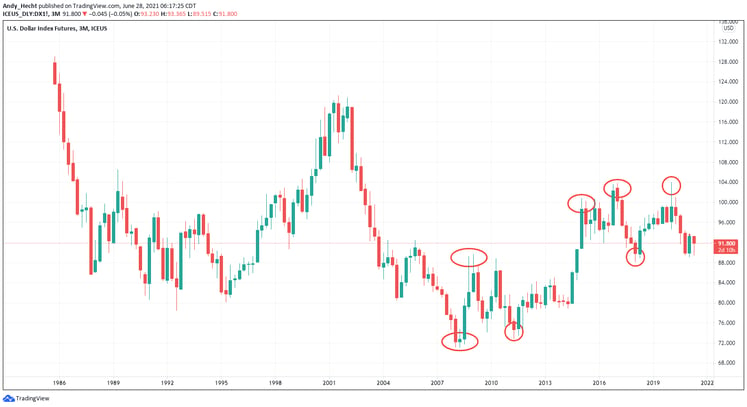June 28, 2021
The Dollar Index Breaks Higher - A Mirage
By Andrew Hecht
- The Fed tightens without tightening credit
- The dollar index breaks above a technical level
- The greenback remains in a medium-term bearish trend
- The long-term trend is higher
- Fiat currency moves are a mirage for one critical reason
After trading at the highest level since 2002 during the risk-off period when COVID-19 spread worldwide like a wildfire, the US dollar index fell, making lower highs and lower lows from March 2020 through January 2021. The index fell from 103.96 to a low of 89.165, a 14.2% decline in the index that measures the dollar against other world reserve currencies.
After consolidating around the 90 level from mid-May through mid-June, the dollar index took off on the upside in the aftermath of the latest Fed meeting. While the dollar has moved higher and eclipsed a short-term technical resistance level, the medium-term trend remains bearish. To confuse matters, the long-term trend dating back to 2008 is bullish for the US dollar index.
Governments and monetary authorities manage currency markets to provide stability for global financial markets. Meanwhile, the overall foreign exchange market is more than a mirage because it is not readily apparent if the asset class gains or loses value in a larger sense. The bottom line is that the dollar and other fiat currencies rely on the full faith and credit of the governments that issue the legal tender. The dollar may be rallying against other currencies, but it can also be losing purchasing power making the entire currency market a farce.
The Fed tightens without tightening credit
At the June Federal Market Committee meeting, the US central bank left the short-term Fed Funds intact at zero to twenty-five basis points. The committee said it would leave its quantitative easing program unchanged and continue to purchase $120 billion in debt securities each month. The only change was a slight increase of five basis points in the reverse repo rate. The bottom line is the Fed continued on its accommodative monetary policy path.
Meanwhile, the central bank increased its GDP growth forecast from 6.5% to 7% and its inflation expectations from 2.5% to 3.4%. While very little changed, the rhetoric shifted towards tighter credit policies as the Fed acknowledged rising inflationary pressures. Seven committee members project a rate hike in 2022, with two expecting two increases in the Fed Funds rate. The markets viewed the statements and rhetoric as a sign that tighter policy is on the horizon and tapering QE will occur sooner rather than later.
Commodity prices fell in the wake of the Fed meeting as rising interest rates increase the cost of carrying raw material inventories and financing production. The dollar moved higher as interest rate differentials are a critical factor for the value of one currency versus another.
The dollar index breaks above a technical level
The dollar index took off on the upside in the wake of the June FOMC meeting, surpassing a short-term technical resistance level.
The greenback remains in a medium-term bearish trend
While the dollar index rose above a technical resistance level, the greenback remains in a bearish medium-term trend despite the recent rally.
The weekly chart shows that the index has made lower highs and lower lows since March 2020. To negate that bearish trading pattern, it needs to rise above the critical resistance level at the 93.47 level from the week of March 29, 2021. If the dollar index stalls and fails to rise above that high, it will put in another lower peak to continue the bearish trend over the past fourteen months.
The long-term trend is higher
To confuse matters, the dollar index’s long-term technical picture remains bullish over the past thirteen years.
The quarterly chart highlights a pattern of higher lows and higher highs for the dollar index since reaching a bottom at 70.805 in early 2008.
With a bullish short-term trend, a bearish medium-term pattern, and a bullish long-term trend, the path of least resistance of the US currency against other world reserve currency remains in doubt. However, it may not matter if the dollar index moves higher or lower against the euro, yen, pound, and other leading fiat currencies. The index could be a mirage masking the overall weakness in the foreign exchange arena.
Fiat currency moves are a mirage for one critical reason
The foreign exchange market only measures the value of one currency versus another. The price differentials tell us nothing about purchasing power other than if one foreign exchange instrument is trending higher or lower against another.
The recent rise in the dollar index that followed on the heels of a more hawkish tone from the Fed could be a mirage. The bottom line is the dollar’s purchasing power has been declining. The May CPI data shows a 5% increase and a 3.8% rise, excluding food and energy. While many commodity prices corrected lower in June, crude oil and natural gas made new multi-year highs. The energy commodities power the US and the world. Rising prices are inflationary.
Inflation erodes the value of money, making it more expensive for consumers to purchase essentials. While the dollar index recovered from the 90 to around the 92 level, the move is a mirage that masks the long-term trend in all fiat currencies. In 2019 and 2020, gold reached a record high in all fiat currency terms. Gold in euros, pounds, yen, dollars and most other foreign exchange instruments rose to record levels. Central banks hold gold as an integral part of their foreign exchange reserves, making the yellow metal a reserve currency alongside the dollar and the euro.
The bottom line is that inflationary pressures continue to rise. The dollar index could continue to power higher over the coming days, weeks, and months, but the US currency could be weakening at the same time. A pivot towards a more hawkish approach to US monetary policy may lift the US currency, but that may only make the dollar the healthiest horse in the glue factory.
Trading advice given in this communication, if any, is based on information taken from trades and statistical services and other sources that we believe are reliable. The author does not guarantee that such information is accurate or complete and it should not be relied upon as such. Trading advice reflects the author’s good faith judgment at a specific time and is subject to change without notice. There is no guarantee that the advice the author provides will result in profitable trades. There is risk of loss in all futures and options trading. Any investment involves substantial risks, including, but not limited to, pricing volatility, inadequate liquidity, and the potential complete loss of principal. This article does not in any way constitute an offer or solicitation of an offer to buy or sell any investment, security, or commodity discussed herein, or any security in any jurisdiction in which such an offer would be unlawful under the securities laws of such jurisdiction.




